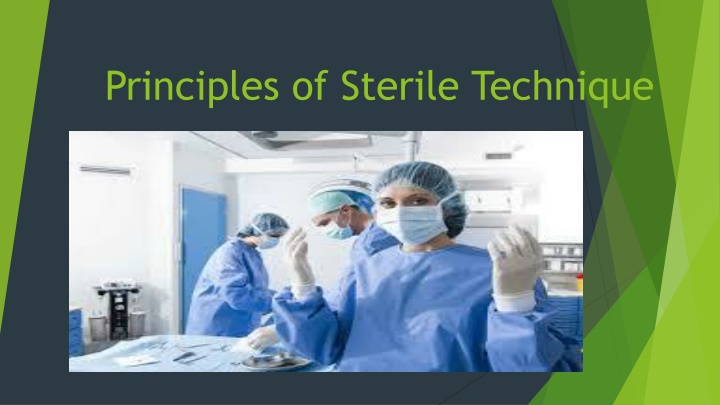
Essential Principles of Sterile Technique in Healthcare
Surgical asepsis is crucial in preventing surgical site infections. This involves maintaining a sterile field, ensuring all objects are sterile, and following strict principles of surgical asepsis to protect patients from infections. Learn about the key principles and practices to uphold sterile techniques effectively in healthcare settings.
Download Presentation

Please find below an Image/Link to download the presentation.
The content on the website is provided AS IS for your information and personal use only. It may not be sold, licensed, or shared on other websites without obtaining consent from the author. If you encounter any issues during the download, it is possible that the publisher has removed the file from their server.
You are allowed to download the files provided on this website for personal or commercial use, subject to the condition that they are used lawfully. All files are the property of their respective owners.
The content on the website is provided AS IS for your information and personal use only. It may not be sold, licensed, or shared on other websites without obtaining consent from the author.
E N D
Presentation Transcript
Surgical Asepsis Asepsis refers to the absence of infectious material or infection. Surgical asepsis is the absence of all microorganisms within any type of invasive procedure. Sterile technique is a set of specific practices and procedures performed to make equipment and areas free from all microorganisms and to maintain that sterility Sterile technique is essential to help prevent surgical site infections (SSI), an unintended and oftentimes preventable complication arising from surgery. SSI is defined as an infection that occurs after surgery in the area of surgery
Principles of Surgical Asepsis All personnel involved in an aseptic procedure are required to follow the principles and practice set forth by the Association of periOperative Registered Nurses (AORN). These principles must be strictly applied when performing any aseptic procedures, when assisting with aseptic procedures, and when intervening when the principles of surgical asepsis are breached. It is the responsibility of all health care workers to speak up and protect all patients from infection
1. All objects used in a sterile field must be sterile. Commercially packaged sterile supplies are marked as sterile; other packaging will be identified as sterile according to agency policy. Check packages for sterility by assessing intactness, dryness, and expiry date prior to use. Any torn, previously opened, or wet packaging, or packaging that has been dropped on the floor, is considered non-sterile and may not be used in the sterile field.
2. A sterile object becomes non-sterile when touched by a non-sterile object. Sterile objects must only be touched by sterile equipment or sterile gloves. Whenever the sterility of an object is questionable, consider it non-sterile. Fluid flows in the direction of gravity. Keep the tips of forceps down during a sterile procedure to prevent fluid travelling over entire forceps and potentially contaminating the sterile field 2
3. Sterile items that are below the waist level, or items held below waist level, are considered to be non-sterile. Keep all sterile equipment and sterile gloves above waist level. Table drapes are only sterile at waist level.
4. Sterile fields must always be kept in sight to be considered sterile. Sterile fields must always be kept in sight throughout entire sterile procedure. Never turn your back on the sterile field as sterility cannot be guaranteed.
5. When opening sterile equipment and adding supplies to a sterile field, take care to avoid contamination. Set up sterile trays as close to the time of use as possible. Stay organized and complete procedures as soon as possible. Place large items on the sterile field using sterile gloves or sterile transfer forceps. Sterile objects can become non-sterile by prolonged exposure to airborne microorganisms
6. Any puncture, moisture, or tear that passes through a sterile barrier must be considered contaminated. Keep sterile surface dry and replace if wet or torn.
7. Once a sterile field is set up, the border of one inch at the edge of the sterile drape is considered non-sterile. Place all objects inside the sterile field and away from the one-inch border
8. If there is any doubt about the sterility of an object, it is considered non-sterile. Known sterility must be maintained throughout any procedure
9. Sterile persons or sterile objects may only contact sterile areas; non-sterile persons or items contact only non-sterile areas. The front of the sterile gown is sterile between the shoulders and the waist, and from the sleeves to two inches below the elbow. Non-sterile items should not cross over the sterile field. For example, a non-sterile person should not reach over a sterile field. When opening sterile equipment, follow best practice for adding supplies to a sterile field to avoid contamination. Do not place non-sterile items in the sterile field
10. Movement around and in the sterile field must not compromise or contaminate the sterile field. Do not sneeze, cough, laugh, or talk over the sterile field. Maintain a safe space or margin of safety between sterile and non-sterile objects and areas. Refrain from reaching over the sterile field. Keep operating room (OR) traffic to a minimum, and keep doors closed. Keep hair tied back.
